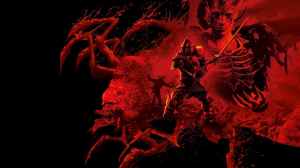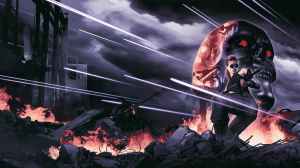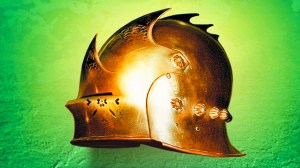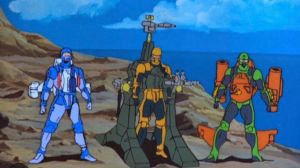There have been a few linchpins in the story of Marvel Comics, whether single issues or massive events, that have helped it become the exact ambitious and ever-evolving superhero epic that it is today. None might be as telling of what Marvel’s future was going to entail as 1962’s Tales to Astonish #35 — the first issue in which Hank Pym, an unassuming scientist who had debuted in the book eight issues prior, suited up as the costumed, size-changing Ant-Man. In that single moment, Tales of Astonish helped show that the terrifying and ridiculous tropes of its creature features and speculative science fiction could successfully carry over into a superhero tale.
Videos by ComicBook.com
Over 60 years later, Ant-Man’s latest appearance, this time in the live-action Ant-Man and the Wasp: Quantumania, is proving to be just as significant a combination of tones. The film is not only the third “act” in the almost decade-long Marvel Cinematic Universe journey of Ant-Man, but it is a forecast of what’s on the horizon — kicking off Phase 5 of the franchise’s storytelling, and fully teeing up its biggest Big Bad yet, Kang the Conqueror (Jonathan Majors). It would be a lot to ask any of Marvel’s existing superhero franchises to carry that latter burden, but in the hands of Quantumania, it proves to be a fun challenge in nearly every way. Ant-Man and the Wasp: Quantumania is an eccentric and essential spectacle, which further expands the possibilities of what the MCU’s tentpole projects can still be capable of.
Ant-Man and the Wasp: Quantumania follows the Lang and Van Dyne families in their new post-Blip status quo — Scott Lang (Paul Rudd) has coasted on his success as an unlikely Avenger (complete with a memoir that will soon be an actual book later this year), Hope Van Dyne (Evangeline Lilly) has utilized size-changing Pym particles for a combination of science and philanthropy, and Cassie Lang (Kathryn Newton) has gotten older, wiser, and more prone to trouble. When the three of them, alongside Hank Pym (Michael Douglas) and Janet Van Dyne (Michelle Pfeiffer), accidentally get thrown into the Quantum Realm, they must find their way home all while dealing with the machinations of Kang, who has lived up to his title as “The Conqueror” and molded the small domain in his image.
Comparisons have (and will continue to be) made between Quantumania and sci-fi juggernauts like Star Wars, which director Peyton Reed helmed multiple episodes of in between the second and third Ant-Man films, and Rick & Morty, which screenwriter Jeff Loveness previously wrote on. While those ties aren’t entirely unwarranted, they sell short the movie’s exact brand of weirdness — if anything, there are clearer shades of both Alejandro Jodorowsky and David Lynch’s infamous adaptations of Dune, and of the outlandish B-Movies that were a dime a dozen when Ant-Man first appeared in the comics. Yes, some viewers’ mileage with Quantumania‘s weirdness, and with some of the jokes that surround it, might vary. Yes, the film does contain some of the strangest visuals and running gags of anything Marvel has put on screen. But when the dust settles, that bizarreness largely works in the Quantumania’s favor — whether it’s Ant-Man and The Wasp using visually absurd gimmicks in their superheroics, or Kang going to the most dramatic extent possible to get what he wants, Quantumania often unfolds exactly like a previously unseen chapter of Marvel’s Silver and Bronze Age comics is playing out on the screen before you.
That exact quality still feels rare in the decade-and-a-half-long venture MCU, and it feels especially satisfying when neither party at the center of the film’s conflict has fought each other in this exact context. The idea of Kang going up against the Ant-Man family has perplexed even the most trusting of MCU fans ever since Majors’ casting was first announced in late 2020, but that juxtaposition — between the cozy, smaller-scale stakes of the previous Ant-Man movies, and the astronomical threat that Kang has posed in the comics — only makes things more enthralling. Granted, it does take some time to get to that point, with one long stretch of the second act ping-ponging back and forth between incremental dumps of exposition. But the narrative tension is palpable once Kang fully enters the picture, and even when certain scenes are incredibly predictable or reverential to another sci-fi staple, you still have no idea exactly how things are going to unfold. All the while, that conflict creates space for some surprising themes, tackling the dichotomy of empathy and apathy in an unexpected way, and even veering towards meta commentary about the entire MCU franchise and its relationship with stakes and spoilers.
Quantumania is truly an ensemble piece, and almost all of the members of its cast are given an opportunity to genuinely shine. Despite Scott now being one of the longest-running veterans still around the MCU, Rudd’s performance feels just as consistently charming and grounding as it did in 2015’s Ant-Man. By his side — arguably much more so than Lilly’s Hope, who, despite her name being on the marquee, largely has a supporting reactionary role in the proceedings — is Newton’s Cassie. Even as the third actress to play Cassie in less than a decade, Newton brings a specific scrappiness and earnestness to every single scene, to the point where it feels like we’ve watched her exact take on the character grow up in front of our eyes. Douglas and Pfeiffer are true to form, but Pfeiffer (rightfully) gets to stand out, showcasing many complex qualities of comic-accurate Janet Van Dyne in spite of the dire circumstances she has endured. And entire odes will be written about Majors’ take on Kang, who turns the extravagant and otherworldly energy from the page into something truly magical, to the point where even the slightest tilt of his head speaks volumes.
It would be a crime not to mention Quantumania‘s technical prowess, which manifests in one of the most ambitious visual feasts that Marvel Studios has put out yet. While some footage from the film’s marketing sparked comparisons to the campy surrealness of Robert Rodriguez’s Spy Kids, the finished product only has a few sore spots of imperfect CGI or wonky depth of field. Once the story really starts escalating, the aesthetic elements manage to be shockingly immersive, thanks to clever feats of cinematography from Bill Pope and costuming from Sammy Sheldon. (The costume Sheldon creates for Kang is so effortlessly effective that it will be interesting to see if and how it evolves to inevitably sell more toys once Avengers: The Kang Dynasty and Avengers: Secret Wars roll around). Christophe Beck’s score ties it all together, bringing voice to the majestic and maddening sequences of the film. By and large, despite Ant-Man and The Wasp being some of the more grounded characters co-created by Jack Kirby, Quantumania is easily a contender for the most Kirby-esque visuals in a superhero adaptation.
On paper, a lot of Ant-Man and the Wasp: Quantumania shouldn’t and couldn’t work — but just enough does work to make watching it a worthwhile experience. Even with the occasional narrative flaw and aesthetic misstep, the film unfolds in a matter that’s not unlike feverishly reading through a forgotten Bronze Age comic book, eagerly experiencing whatever story crumbs or impossible visuals might be in store. With multiple standout performances, an abundantly clear love for the wacky corners of science fiction, and a conflict that is guaranteed to matter in the years to come, Quantumania becomes the weirdest and most wholehearted chapter in the MCU’s essential storytelling.
Rating: 4 out of 5
Ant-Man and the Wasp: Quantumania will arrive in theaters on Friday, February 17th.








